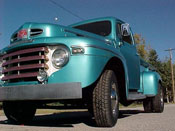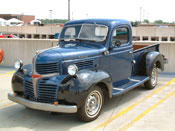| Welcome to DEPTCA - Dodge Pilot-house Era Truck Club of America. |
This organization, and this website, is dedicated to the Pilot-house era of Dodge and Fargo trucks (1948 - 1953). We have tried to create a website that can be your central site for information not only about these great trucks, but also the people who are interested in them.
This site will provide information about the DPETCA club, galleries of pictures of pilot-house trucks, and an ever growing knowledge base of information about restoring and modifying these trucks. After you're done then come on over to the "fun-rated" section and find some movie clips that show our "pilots" in the movies, great truckin' music, and a game or two.
Please consider joining this great nationwide (and international) organization. As we grow we should be able to organize regional meets and tours. In time we should be able to organize an annual national Pilothouse event, and also establish valuable parts and supplies resources. We invite you, the "pilot-house" enthusiast to come grow with us.
Tell me more about membership
|
| A Brief History of Dodge |
-
John and Horace Dodge began their careers as automotive parts suppliers, helping launch both Oldsmobile and Ford. The Dodges introduced their first vehicles in 1914. Personally tested by the Dodges, their products were advertised as "dependable." Dodge owners boasted of "dependability" and put a new word into common use.
-
A bighorn ram was among the animals sculptor Avard Fairbanks proposed for a Dodge symbol in 1932. Selling the idea to a dubious Walter P. Chrysler and corporate executives Fairbanks explained the animal was "king of the trail," adding "Besides, if you saw one on the trail in front of you, you'd think—'Dodge!'" Chrysler immediately agreed, "That's it! The Dodge gets the ram!" And it did, beginning with the 1933 models. In 1981 the ram moved beyond a symbol as Dodge Ram became the formal name for the company's full-size trucks.
-
Dodge began promoting its trucks as "Job-Rated"—designed for specific service demands—in 1939. Customers met the theme with immediate and favorable response and, after more than six decades, it's still synonymous with Dodge Trucks. Truck collectors refer to the 1939—1947 Dodge models as the "Job-Rated Trucks."
-
The Dodge Brothers' special relationship with the military began in 1915 when the Army ordered touring vehicles that proved rugged enough for Army use. Entering World War I, the U.S. took thousands of Dodge vehicles into France as staff cars, trucks and ambulances. During World War II, Dodge built nearly 400,000 trucks that saw service worldwide, as well as tens of thousands of aircraft, marine and industrial engines.
-
Of the nearly 400,000 trucks that Dodge built during World War II, more than 255,000 were 3/4 ton 4 x 4 military trucks with a reputation for extraordinary durability. Dodge engineers used the truck, post-war, as the basis for its powerful, versatile Power Wagon models. So successful was the Power Wagon that it remained in domestic production until 1968; it was built for export for four more years.
-
In 1939 Dodge was the first truck maker to design and build its own diesel engines for heavy duty trucks. But it wasn't until 1989 that Dodge introduced a diesel pickup, trumping the competition with a 6-cylinder 5.9L turbo-diesel manufactured by Cummins Diesel. The Ram diesel used a turbocharged direct injection engine that delivered 160 hp and 400 lbs.-ft of torque, surpassing many V-8s. The partnership was so successful that more than a million Ram Trucks wore the Cummins side badge by May 2003.
Above information from Walter P. Chrysler Museum website
|
| 1948 - Dodge Introduces A New Truck Design |
The first new truck models since 1939 came in 1948 with the Pilot-house models. The name came from the industry first cab with increased glass for better visibility and a higher, more spacious cab. The engines were moved forward and the front axles were moved back for better weight distribution as well as a shorter wheelbase, moving from 116" down to 108". This, along with a redesigned axle steering design gave these trucks a tighter turning radius, and a more comfortable ride. The cargo bed sides were made higher to allow a 40% increase in capacity. The truck cab could now seat 3 men (the average man weighed 135 pounds in those days) with 2.5 inches more height, 6 inches more width and 3 inches added in length. The cab was mounted on rubber mounts also for an improved ride. The long hooded aerodynamic look of previous models was giving way to better balance for the truck and comfort for the riders.
In 1950 more new features were added such as the 3 speed shift lever was relocated to the steering column instead of on the floor. A fluid drive automatic became an available option. The trucks G.V.W. was increased from 7,500 lbs. to 8,000 lbs. And the front end was redesigned.
1953 was the last year of the Pilot-house, but brought many new changes. The "truck-o-matic" transmission, a fully automatic transmission was available for 1/2 and 3/4 ton models. A longer 7 1/2 foot bed became available, which would increase the wheelbase to 116 inches. And the new wide "stepside" rear fenders were added, which would continue to be used by Dodge up until the 80's.
More complete history about Dodge trucks from the Chrysler Museum
|
A Pictoral Comparison of Pilot-house Trucks
with other truck years and models. |
|
|
|
|
| 1947 Chevy Pickup |
1947 Hudson Pickup |
1946 GMC Pickup |
1947 International Pickup |
 |
 |
 |
 |
| 1948 Ford F1 |
1948 Mercury Pickup |
1948 Hudson Pickup |
1947 Dodge Pickup |
|
|
1948 Dodge Pilot-house Pickup at the Walter P. Chrysler Museum |
| |
| Increase your knowledge about Dodge Trucks by ordering from below and supporting DPETCA at the same time. |
|
|
|